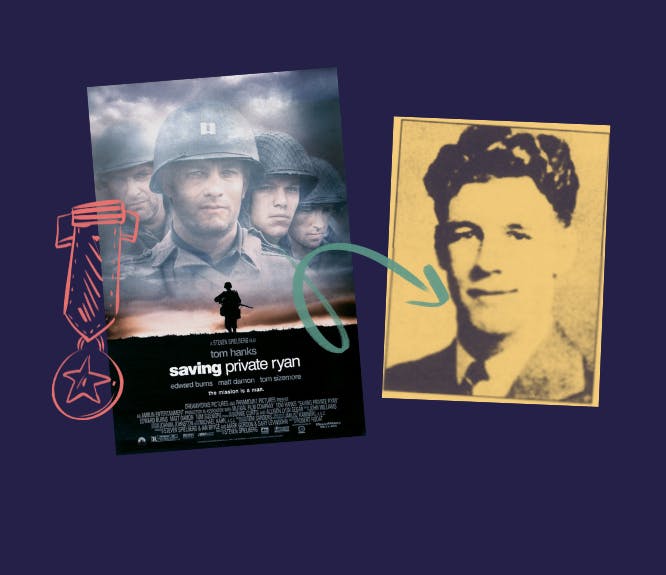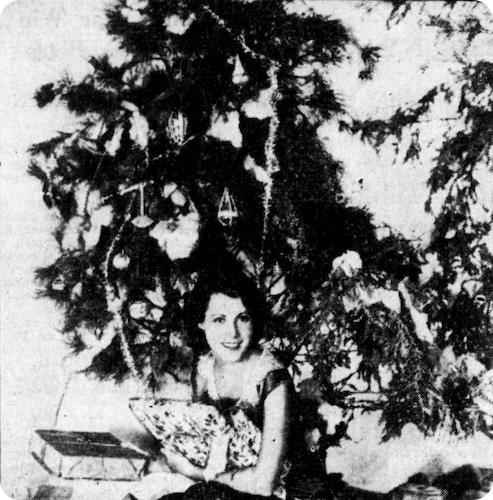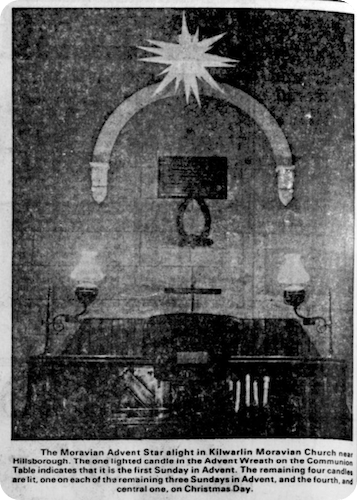The secret histories of your Christmas decorations, found in old newspapers
6-7 minute read
By Daisy Goddard | December 4, 2024
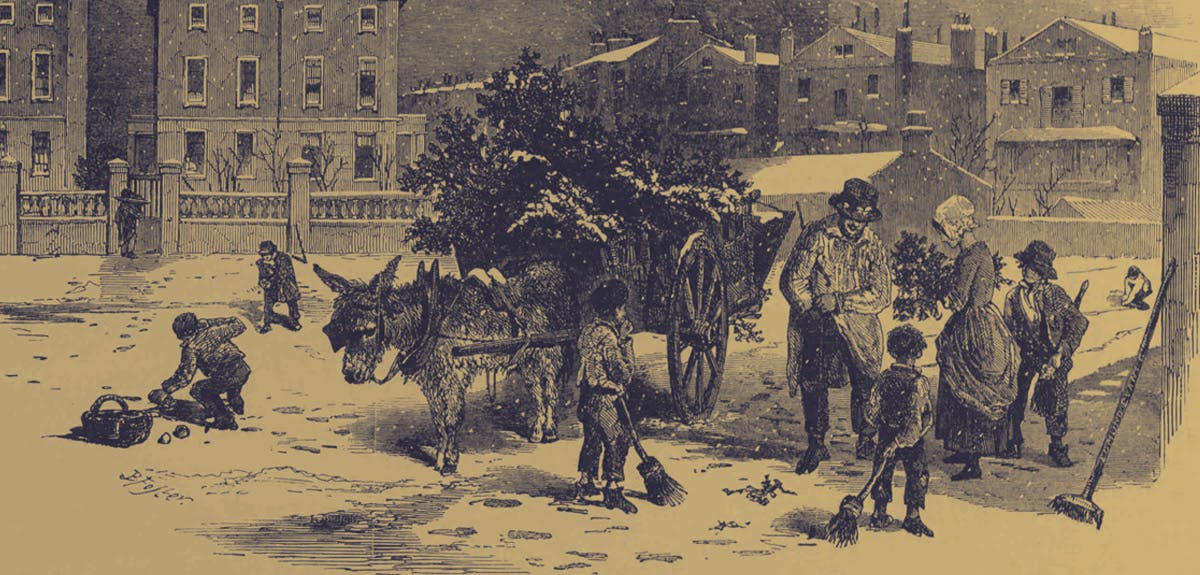
From edible Christmas decorations to baubles and Moravian stars, we use all sorts of things to decorate our trees over the festive season. Using our newspaper collection, we've delved into their history.
According to The British Christmas Tree Growers Association, about 7 million evergreen conifer Christmas trees are sold in the UK every Christmas season, with 85% of UK homes having a tree each year.
Whether it's getting out sentimental homemade decorations or the youngest having the job of putting the star on the top of the tree on Christmas Eve, every family has their unique Christmas tree traditions.
The origin of these traditions isn't something that we usually give much thought to, but with a little digging into our newspaper collection, we've uncovered some fascinating Christmas tales.
Read on to learn more about the stories behind the much-loved tradition of the Christmas tree, as told through our historical records and newspaper pages.
The history of the Christmas tree
As many already know, the British Christmas tree as we know it was popularised by Queen Victoria and Prince Albert, who were pictured with a beautifully adorned tree in the Illustrated London News in 1848.
Before this, it was only Germans in the Protestant Rhine area who brought trees into their homes to celebrate the holiday season.
From the mid-19th century, newspapers like the London Illustrated News documented royal trees each year, and the number of ordinary homes with a Christmas tree grew year by year.
Much like a family tree - which is brought to life by the family members and rich details that we add to its branches - a Christmas tree comes alive with the decorations that we add to it. From twinkling fairy lights to gingerbread, here's what our newspapers uncovered about this much-loved seasonal tradition.
The stories behind your festive favourite Christmas decorations
Fairy lights
The history of Christmas lights as we know them today dates back to the development of electric lighting, in both Britain and the United States. Before the invention of electrical lights, candles were used to illuminate Christmas trees - but this posed a serious safety hazard. 19th-century newspapers contain many cautionary tales of the dangers of using real fire with a flammable tree.
On 28 December 1885, the Globe reported a tragic fire that took place in a 'crowded hospital in Chicago'.
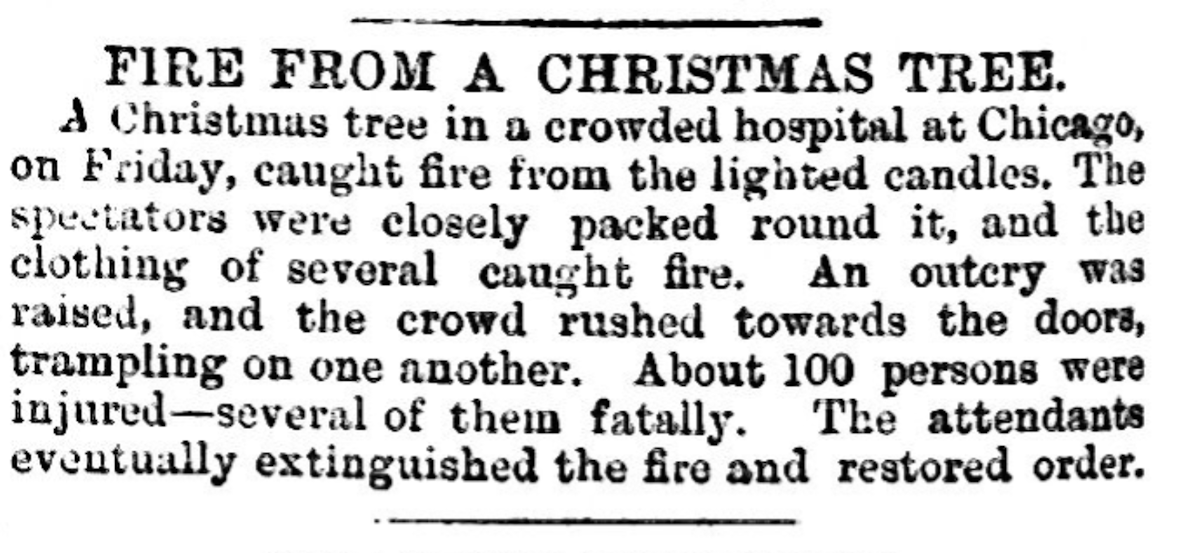
Globe, 28 December 1885. Explore this page.
When the candles used on the Christmas tree lit the tree's branches alight, the clothing of the spectators that were 'closely packed round it' caught fire. 'About 100 people were injured - several of them fatally before attendants could extinguish the fire and 'restore order'. Thankfully, the advent of electric lighting presented a far safer option Christmas festivities.
In the US, Edward H. Johnson invented the very first string of electric tree lights in 1882. A friend and partner of Thomas Edison, Johnson hand-wired 80 red, white and blue bulbs. His handiwork hit the national stage in 1895 when President Grover Cleveland requested electric lights for the White House's Christmas tree.
Electric Christmas lights were gaining popularity in the UK around the same time. Sir Joseph Swan is considered the 'Father of Fairy Lights'. His work was displayed in some of Britain's most visible places, including the Savoy, which was the first public building in the world to be lit entirely by electricity. In 1882, Joseph Swan created miniature lights for the opening of Gilbert and Sullivan's opera Iolanthe.
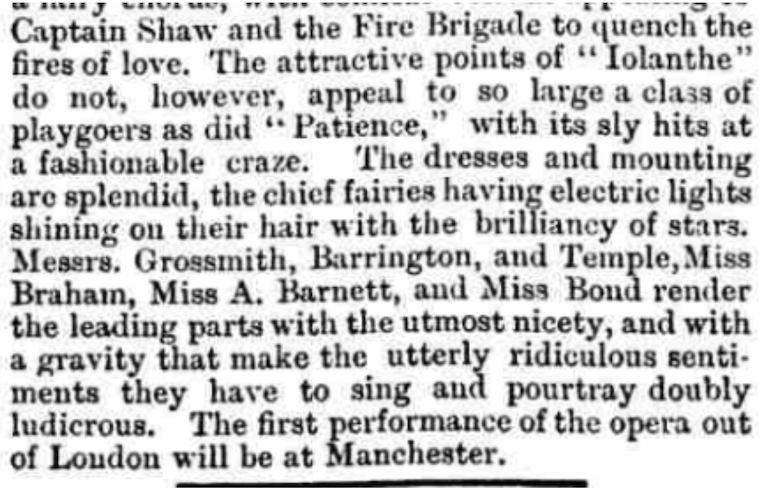
Derby Daily Telegraph, 28 November 1882.
Fairy lights were a Christmas tree staple in Britain by the early 1900s.
Edible decorations
It's common today to see biscuits atop a Christmas tree - this tradition also has a long history.
During the wartime and interwar years, when money was particularly tight, edible decorations and garlands were an economical option for decorating Christmas trees - though these were a far cry from the shortbread and gingerbread that we typically enjoy today.
In December 1935, The Witness offered ideas for 'economic Christmas decorations' in the form of carrots, beets and gourds. The article outlines how common vegetables could be threaded with cord or wire and painted in bright colours to bring a little festive cheer to an empty tree. Blown eggshells were also recommended.
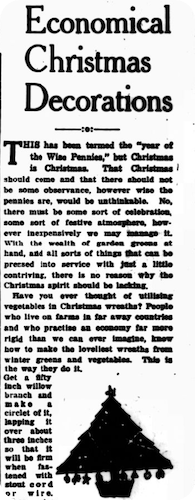
The Witness, 13 December 1935.
An article in the Evening News in 1938 offered even more edible suggestions to readers -
"Red apples tied on with bright ribbon, gilded nuts, bags of sweets, chocolate animals in silver paper, lengths of tinsel and crackers all add to the decorative effect at small cost."
But the suggestions didn't stop there.
As described by the West London Observer in 1958, walnuts were also recommended. As the newspaper describes, the walnut shells could be separated and decorated with silver lacquer, forming eye-catching makeshift baubles.
Tinsel
Made from thinly sliced silver, tinsel was first produced in Nuremberg, Germany in the 17th century. It was used to adorn statues and buildings to mark special occasions - interestingly, it was also woven into cloth to give it a beautiful shine.
Tinsel was a popular decoration by the early 1900s. You could find it on greeting cards as well as on trees. Manufacturing advances meant that tinsel could be made from aluminium or lead, which was cheaper to produce.
Funnily enough, the history of tinsel wasn't all smooth sailing. As an article from 1907 reveals, the Postmaster General requested that people stop sending Christmas cards decorated with metallic tinsel in the post, as postal staff were being injured.
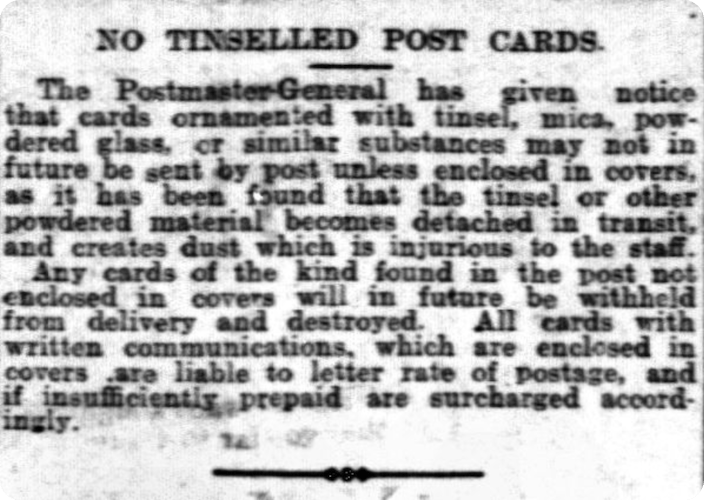
The Postmaster's warning, as reported by the Airdrie & Coatbridge Advertiser, 27 July 1907.
Due to a combination of scarcity, technological development and health concerns, synthetic materials had replaced metal tinsel by the 1950s.
Moravian stars
The 26-point star commonly seen on Christmas trees today has a history that spans almost 200 years. Moravian Stars began with a geometry project in the 1830s, at the Moravian Boys' School in Niesky, Germany.
With around 750,000 members worldwide, the Moravian faith is an offshoot of Lutheranism. It originates in Moravia, a historical region in the Czech Republic, with roots also in Herrnhut, Saxony.
The Moravian star was popularised in the 1880s when Niesky school alumnus Peter Verbeek started producing them through his bookstore. His son Harry founded the Herrnhut Star Factory, which produced the Moravian stars up until World War 1.
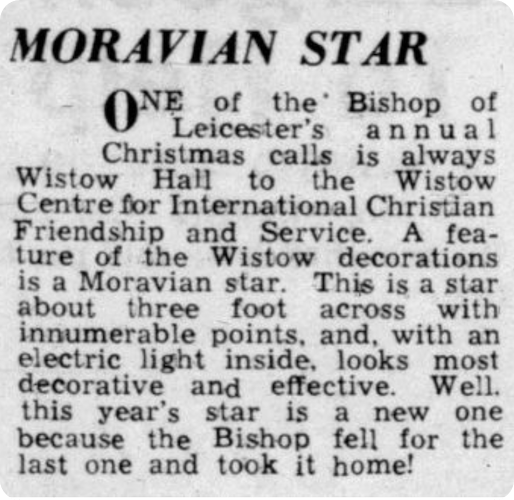
Belfast News-Letter, 23 December 1976.
The factory suffered heavy damage during World War 2, but resumed manufacturing after being taken over by the East German government in the 1950s. It was eventually turned over to the Abraham Düringer Company - which is owned by the Moravian Church - and is still operational today.
Baubles
Hans Greiner, a German glassblower, is traditionally credited with the invention of baubles in the 1500s. He created strings of decorative glass beads, as well as tin decorations, to adorn houses over the Christmas period.
In 1848, an engraving of Queen Victoria and her family celebrating around Windsor Castle's Christmas tree, adorned with glass baubles, caught the popular imagination and soon became mainstream.
Up until World War 1, baubles were mostly imported from German manufacturers, with popular styles including fruit, birds, flowers and bells. From the 1950s, baubles became more readily available to British consumers thanks to advances in production methods, and increased import of European goods at a cheaper price.
Build your family tree with Findmypast
Although we typically take down our Christmas trees at the end of the festive season, the magic of a family tree can be enjoyed all year round.
When decorated with key facts, stories and even photos of family members, your family tree can truly come to life, and help all of us to remember the lives of our ancestors.
Whether you're a genealogy expert or a total beginner, our handy tree-builder makes researching your family history easier than ever. Why not build your family tree with Findmypast today?
From celebrity family trees to the origins of your favourite Christmas song, the Findmypast blog is your one-stop shop for all things family history. Delve even deeper into fascinating stories from the past by visiting our History Hub. With Findmypast, you never know what you might discover...
Related articles recommended for you
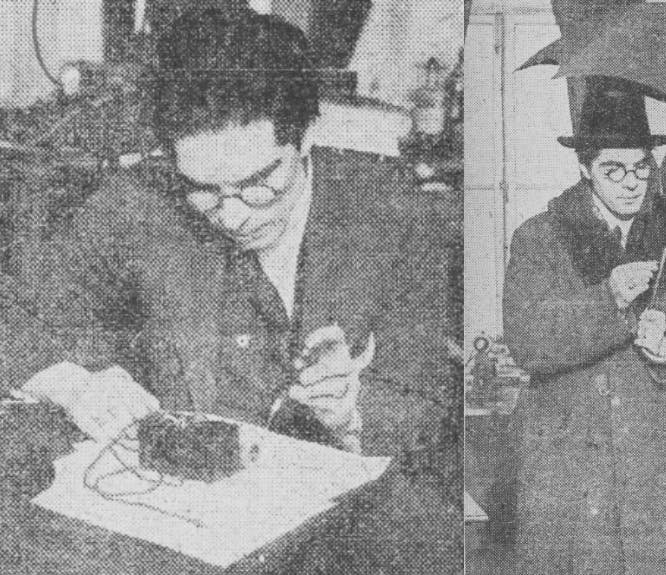
This ‘ruthlessly imaginative’ professor made predictions for 2025 – and they’re spookily accurate
History Hub
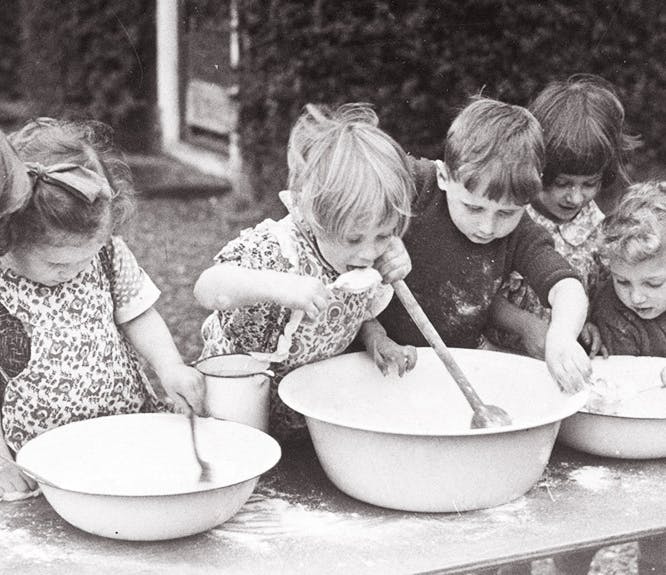
Five Christmas recipes from history you can make and enjoy today
History Hub
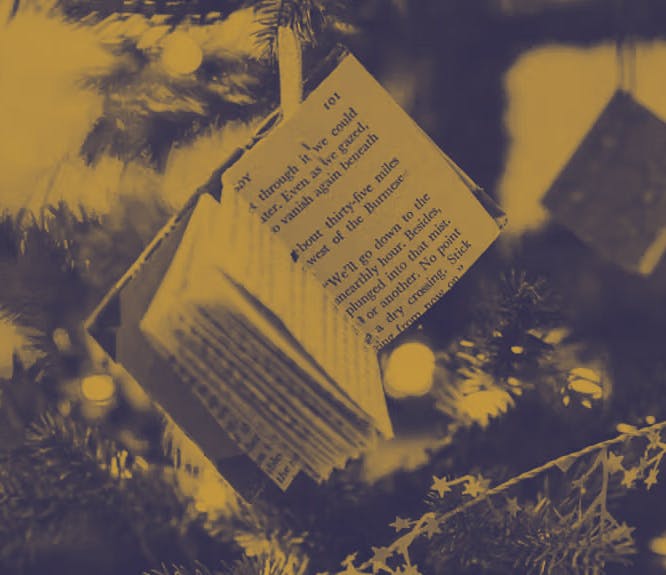
The history of the Christmas tree: how Queen Victoria introduced America to the Christmas tree
History Hub
